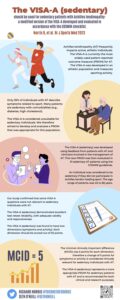The VISA-A (sedentary) should be used for sedentary patients with Achilles tendinopathy: a modified version of the VISA-A developed and evaluated in accordance with the COSMIN checklist.
Keywords: Achilles tendinopathy, sedentary, patient reported outcome measure.
In this blog, we will explain how we developed and evaluated a modified version of the Victorian Institute of Sport Assessment Achilles (VISA-A) questionnaire (1), to be used in sedentary patients with Achilles tendinopathy. Our study took approximately 7 years from inception to publication, partly due to interruptions caused by the COVID-19 pandemic.
Why is this study important?
Achilles tendinopathy (AT) is a common condition that is often seen in the athletic population, especially runners (2). However, only 35% of patients presenting to general practice with AT describe symptoms related to sporting activity (3).
Our clinical experience was that the widely used VISA-A questionnaire was not suitable for typical NHS patients who often presented with comorbidities, did not participate in sports, and were unable to hop on either leg. Single leg hopping (Q6) and sporting activity (Q7-8) account for 50% of the total score on the VISA-A, with sedentary patients unable to achieve any points for the sporting activity domain. This produces a ‘floor’ effect, whereby a substantial proportion of individuals obtain minimum scores, making it difficult to determine the true extent of their abilities. Amongst other issues, patients often recorded their pain inaccurately on the VISA-A by incorrectly assuming the left side of the visual analogue scale (Q2-5) represented ‘no pain’. Likewise, patients would mistakenly tick multiple boxes on question 8; if you have ever sat with a patient whilst completing the VISA-A, you will have ‘fond’ memories of discussions around this question. Consequently, the VISA-A’s usefulness appeared limited for benchmarking services and measuring change during our research.
The need for relevant, reliable, valid, and responsive patient reported outcome measures (PROMs) in clinical care and research is self-evident and the proportion of patients that the VISA-A is unsuitable for is considerable. This is likely to have impacted the outcomes of interventions for AT investigated over the last 20 years, particularly in sedentary patients. We therefore decided to work together to develop such a PROM.
How did the study go about this?
We used the Consensus-based Standards for the selection of health Measurement Instruments (COSMIN) recommendations (4) to develop and evaluate the VISA-A (sedentary). Sedentary patients with clinically and MRI-confirmed AT were asked to complete the VISA-A and provide feedback on the relevance, comprehensiveness and comprehensibility of each question, response options and instructions. Patients were also asked to offer alternative suggestions, based on their experience with AT. Patient feedback was discussed with professionals from relevant disciplines (physiotherapists and consultant orthopods). A preliminary version of the VISA-A (sedentary) questionnaire was created and adapted until no further changes were recommended by patients or professionals.
The VISA-A and final version of the VISA-A (sedentary) were then evaluated in 51 sedentary patients with AT. Patients completed both PROMs before and after treatment; the VISA-A (sedentary) was also repeated 3-days after the initial assessment to determine its test-retest reliability. The change in scores for each questionnaire was compared with the patients’ global rating of change (GROC) score.
What did the study find?
Patient feedback and measures of internal consistency confirmed that some VISA-A questions were not relevant for sedentary individuals. Other issues were identified regarding the comprehensiveness, comprehensibility, response options and instructions of the VISA-A. Patients also recommended that the duration of pain after stopping a provocative activity should be included in the modified questionnaire.
The VISA-A (sedentary) demonstrated excellent test-retest reliability. There was a stronger correlation between the VISA-A (sedentary) and the GROC than the VISA-A. Exploratory factor analysis identified the VISA-A (sedentary) as a two-dimensional PROM, therefore the symptoms (Q1-5) and activity (Q6-8) dimensions should be scored out of 50 points each. The minimal clinically important difference (MCID) was 5 points for each dimension, indicating that a change of 5 points for symptoms or activity is clinically relevant for sedentary individuals with AT.
What are the key take-home points?
The VISA-A (sedentary) represents a more appropriate PROM for sedentary patients with AT and will better enable clinicians and researchers to assess the impact of AT and efficacy of specific interventions. As such we recommend its use both clinically and for research purposes.

References:
- Robinson JM, Cook JL, Purdam C, et al. The VISA-A questionnaire: a valid and reliable index of the clinical severity of Achilles tendinopathy. Br J Sports Med 2001;35:335–41.
- van der Vlist AC, Breda SJ, Oei EHG, et al. Clinical risk factors for Achilles tendinopathy: a systematic review. Br J Sports Med 2019;53:1352–61.
- de Jonge S, van den Berg C, de Vos RJ, et al. Incidence of midportion Achilles tendinopathy in the general population. Br J Sports Med 2011;45:1026–8.
- Mokkink LB, Terwee CB, Knol DL, et al. The COSMIN checklist for evaluating the methodological quality of studies on measurement properties: a clarification of its content. BMC Med Res Methodol 2010;10:22.
Authors of blog: Richard Norris and Seth O’Neill .